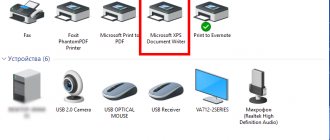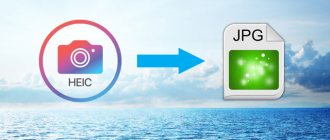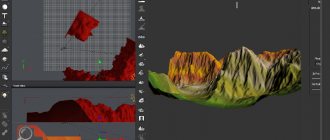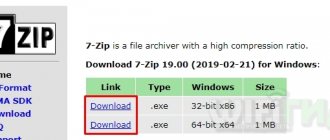- 7shared
- 0Facebook
- 7Twitter
- 0VKontakte
- 0Odnoklassniki
All raster graphics editors, even the simplest ones, are capable of saving images in different formats. Classic Paint offers a choice of six formats, Adobe Photoshop and other professional tools - dozens. But why such a huge number of formats if you can get by with just a few, and why hasn’t a single format been developed yet that removes all the limitations and difficulties that arise when working with different types of images?
The answer sounds quite simple - each of the formats has its own unique, and sometimes mutually exclusive, set of features that allows you to use the image in a certain area with maximum efficiency. This is, for example, the TIFF or TIF format, which we will talk about today. You have probably come across this format, which is quite remarkable in many respects more than once, but most likely you have not thought about its features and advantages, just as you have not wondered how to open TIFF.
TIFF - what is this format?
And yet, what is TIFF for, and why is it so good? Let's start with the fact that TIFF and TIF are the same format. TIF and TIFF files have an identical structure, the only difference is in the extension. The format was born in 1986 thanks to the joint efforts of Microsoft and Aldus Corporation and was originally used in the PostScript page description language. For some time it had the status of the main graphics format in the NeXTSTEP OS, and due to its ability to store image data with a large color depth, it was adopted by manufacturers of cameras and printing equipment.
Features, advantages and disadvantages
Currently, TIFF is actively used in printing, when sending faxes, digitizing printed documents, and also as an intermediate format for saving projects in graphic editors. An example of this is a multi-page TIFF, which is often saved as a PDF document after final editing. TIFF also occupies its niche in photography, being positioned as an alternative to the “raw” RAW format.
TIFF, like JPEG, uses compression (it is optional), but unlike the popular format, compression in TIFF practically does not lead to loss of quality, however, much depends on the algorithm. So, if the TIFF file is intended to be printed, it is necessary to give preference to images without compression or compressed using the LZW or ZIP algorithms. Another important advantage of the format is its support for a wide range of color spaces, among which binary, grayscale, indexed palette, RGB, CMYK, YCbCr and CIE Lab are available. Also noteworthy is TIFF's ability to store both raster and vector data, which makes it a universal format like PDF.
But versatility comes at a price. The format is not without its drawbacks, among which the most important is the significant size of TIF files, which weigh at least 10 times more than JPEG files. Their large size limits the use of this type of file on the web; moreover, their viewing is not supported even by the most popular browsers. Problems with displaying TIFF images can also occur on phones, DVD players and other mobile gadgets. Among other disadvantages of the format, it is worth mentioning the low speed of continuous shooting in photography, higher consumption of computer resources during processing and irrational use for everyday needs.
Programs for reading TIFF files
We hope it’s clear what the TIFF format is and where it is used, now let’s move on to the question of how to open it. By and large, you won’t need any third-party programs for this. To view TIFF images, you can use either the built-in photo viewer in Windows 7 and 8.1 or the universal Photos app in Windows 10. But you can just as easily resort to third-party viewers.
XnView
One of the most popular and best image viewers, supporting more than 400 graphic formats. If you are looking for a way to open TIFF format, install XnView and forget about all your problems at once. The application will allow you not only to view, but also to convert files of different formats between each other. There are many additional functions available, including editing, working with metadata, creating HTML pages, resizing images, taking screenshots, counting the colors used in a picture, applying various filters and effects, and much more.
How to make a multi-page TIFF? You can easily assemble it in XnView. Select Tools – Multi-page file – Create from the program menu, add “glued” files to the program, specify the folder to save and click “Create”. Sources can be not only individual TIFF files, but also images of other formats. Additionally, it supports setting the parameters for creating a multi-page file - by clicking the “Options” button, you can select the compression algorithm and output image quality.
FastStone Image Viewer
Another popular tool that combines the functions of a viewer, graphic browser, converter and image editor. The program supports working with metadata and thumbnails, levels and curves, resizing images using eleven algorithms, creating screenshots, color correction, adding watermarks, red-eye removal, applying visual effects and batch processing.
FastStone Image Viewer's capabilities also include the creation of multi-page PDF and TIFF files. The option is available from the Create menu. The sequence of actions is approximately the same as in XnView - the user is asked to select an array of files to be merged, specify the format and compression, while the program allows you to set the size of the output image and apply a shadow effect to it. You can also use FastStone Image Viewer to create index sheets, slide shows, and image feeds.
IrfanView
A small but quite functional program for viewing graphic files. The user who installs IrfanView will have access to such functions as color correction, reading metadata, including when working in full screen and slide show mode, creating screenshots, receiving images from scanners, extracting icons from executable EXE, DLL and ICL files, creating based on images web pages.
In addition to opening TIFF files, IrfanView supports combining them into multi-page images. To create such a file, in the application menu you need to select Options – Multipage images – Create Multipage TIF, create a list of objects, specify, if required, the compression method and other parameters, and then start the creation procedure by clicking the “Create TIF image” button. The program has many other useful functions, for example, video and audio playback.
Picasa
This program is an image manager with basic editing tools. Picasa allows you to view and organize images, apply simple effects to them, and share them with other users via social networks, email, and a special web service. The program is a good help in creating collages, slide shows, presentations and videos. You can also use it to create backup copies of images on CD or DVD, and add tags and geo-coordinates to the metadata. In terms of functionality, Picasa is inferior to the three previous programs, but copes with viewing TIFF no worse.
ACDSee Free
How else to open TIF? If you don't need a lot of editing features, try ACDSee Free, a free version of the popular image organizer. The program is characterized by high speed and a wide range of printing settings. Among the additional features of the tool, it is worth noting the expanded scaling options, as well as the use of gamma correction.
What programs can open TIFF on Android
DOC and DOCX documents - how to open on Android
All phones come with standard applications for viewing different files. However, these programs are usually very simple and have few features. Sometimes it's better to download an application to work with files faster and more efficiently.
Opening TIF in File Viewer for Android
AA Image Viewer
A very good application that can be an excellent alternative to your phone's image gallery. It has its own real-time rendering engine, as well as various presentation modes for viewing files.
Note! Comes with various options for searching photos and the ability to sort by name or date.
There are even basic editing options. This is one of the best options considering the user ratings, constant updates and the fact that the application is free.
Fotos A+ & Videos
One of the best applications for viewing images. Simulates a photo gallery in iPhone style. Free, receives frequent updates.
Gallery Activity
Another photo viewer for Android can be easily downloaded from the Play Store. Gallery Activity supports the most popular formats such as BMP, JPEG, PNG, ICO, PCX and TGA. The app also comes with a magnifying glass feature for viewing details, including cropping, rotating, zooming, and batch processing options. You can also play images in GIF format. However, the application has not been updated for a long time.
Galeria QuickPic
The best app for viewing photos on Android. At least the unusually high rating on Google Play can't lie. The app is fast and lightweight and its design is also quite attractive.
For your information! The program has an interesting ability to hide those photos from the Android gallery that you don’t want to look at. You can also put a password on the photo.
My Roll
An application available on both Android and iOS. MyRoll is a “smart” gallery that knows what is most important for each user, and can bring order to photos and videos from the first launch. These moments are related to the place, date and event in which the photograph was taken. This way, the chances of finding a photo on your phone quickly increase.
Before downloading an image viewer, it is best to select the file option that best suits your needs.
How to open a TIFF file online
If for some reason you can't view the TIFF (associations failed, you're using a mobile device, etc.), it's easy to open the TIFF online using one of the web tools.
TIFF Viewer Online
A simple resource for viewing different file types, including TIFF. Extremely simple to use. The file is uploaded from a computer or via a URL to a server, where it is converted into a format viewable in a browser. The “View” link opens the file for viewing in a separate tab, the “Delete” link deletes it from the server. You can also select the quality of the picture you are viewing. The service is available at www.ofoct.com/viewer/tiff-viewer-online.html.
CoolUtils.com
Using this service you can combine TIFF files into one online. The operating principle is simple. The user uploads files to the server one by one, clicks the “Combine My Files” button and immediately receives the assembled file. Unfortunately, the number of added files is limited to five, and there is also no option to configure settings. Only TIFF files can be combined using the service. The web tool is located at www.coolutils.com/ru/online/TIFF-Combine.
Jinaconvert.com
The Jinaconvert.com web converter (jinaconvert.com/ru/convert-to-tiff.php) provides slightly more opportunities for creating multi-page TIFFs online. Unlike CoolUtils.com, you can upload significantly more files at one time, and they don't necessarily have to be in TIFF format. In this case, TIFF is the output format, and JPEG or PNG images can be used as sources. The web tool does not allow you to configure conversion parameters.
What is better to use
The TIFF format is not one of the “exotic” formats, so standard Windows tools do an excellent job of opening it. As for mobile platforms such as Android, to view TIFF images you will need special programs, which, however, can be easily found in the Play Market. When it comes to creating multi-page TIFFs, preference should be given to third-party programs, since online services offer very meager functionality in this regard, not so much creating PDF-type pages as simply merging individual files into one long canvas file that is not convenient for viewing.
- 7shared
- 0Facebook
- 7Twitter
- 0VKontakte
- 0Odnoklassniki
File with .tif extension
How to open, description – 2 file formats
- TIF Image File - Raster Images
- TIFF image in geospatial format GeoTIFF - Raster images
1. TIF Tagged Image File
File Type: Raster Images
Data Type: Binary File
Developer: Unknown
Heading and Key Lines
HEX: 4D 4D 00 2B, 4D 4D 00 2A, 49 49 2A 00
ASCII: MM.+, MM.*, II*
Detailed description
TIF is a graphics format often used to store images with a wide range of colors, such as digital photographs or scanned documents. One of the big advantages of the format is its support for tags and the ability to save multiple images into one file.
Thanks to tags, the format is extensible and additional information can be stored in TIF files. For example, in Adobe Photoshop you can optionally save layer information to a TIF file.
TIF files can be saved either without using compression at all, or using it using JPEG, ZIP, LZW and some other algorithms. Compressing a TIF image using the ZIP and LZW algorithms allows you to reduce the file size without loss of quality.
How to open a .tif file?
WindowsOnlineAndroidiOSMac OSLinux
|
Instructions - how to select a program from the list, download and use it to open a file
Similar formats
.piv - Pivot Stickfigure Animation
.nim — Nim source code file
.ect - Yozo Office Chart Template
.err — FoxPro compiler errors
.rdb - Nintendo 64 Database File
2. TIFF image in geospatial format GeoTIFF GeoTIFF Image
File Type: Raster Images
Data Type: Binary File
Developer: Adobe Systems
Detailed description
A raster image in TIFF format, supplemented with spatial information that is embedded in the file in the form of geo-tags and indicates a geographic reference. Files of this format often store satellite images of the Earth's surface, area maps, etc.
Geotags contain metadata about the coordinate system and spatial region to which the image belongs; spatial extent, size, resolution and number of layers, as well as other parameters. The coordinates specified in the labels allow geographic information software to display specific areas of the image on the map based on longitude and latitude.
A GeoTIFF image is intended for GIS applications and systems, but can be opened as a regular raster image using any graphics viewer that supports the TIFF format.
How to open a .tif file?
WindowsMac OSLinux
|
Instructions - how to select a program from the list, download and use it to open a file
Similar formats
.jpe — JPEG image file
.gid - Windows Help global index file
.bmml - Musical score Braille Music Reader
.pnf — Precompiled INF file
.jpf — JPEG 2000 image file
To more accurately determine the format and programs for opening a file, use the function of determining the file format by extension and by data (header) of the file.











